A Low Power OOK Digital Transceiver: Moving Forward PowerPoint PPT Presentation
1 / 19
Title: A Low Power OOK Digital Transceiver: Moving Forward
1
A Low Power OOK Digital TransceiverMoving
Forward
- Louise Crockett
- University of Strathclyde
- louise.crockett_at_eee.strath.ac.uk
2
Summary
- Purpose of Manchester OOK Development System
- Tested design
- Area, data rate and power
- Planned experiments
- Testing with RF link
- Improvements and modifications
- Conclusions
3
Glasgow / Strathclyde Development System
- Aims
- To achieve point-to-point communication over a
wireless link - To design for simplicity and low power
- To grab transmitted and received signals for
use in simulation - To identify the limitations of the system
- To estimate power
- Transmitted power
- Received power
- Power consumed by components
4
Data flow
Output signal to RF
Packet data
Serial data
Manchester Encoding
1V
0V
XOR
Manchester encoding ensures a transition in the
middle of every bit period.
This signal is used to switch an oscillator on
and off
Packet details 32 bits preamble 8 bits SOF
delimiter 256 bits payload
5
Manchester OOK Transceiver Test System
6
Progress
- Proof of successful transmission and reception
through a wire - Visual inspection of oscilloscope trace
- SOF delimiter easily identifiable
- Pattern of data elsewhere in packet
- Next step is to quantify performance
- Signal to noise ratio (SNR)
- Bit error rate (BER)
- Develop method for making relevant measurements
- Can bit errors be counted on-chip?
7
Test System Analysis
- Aspects to analyse
- Sample wordlength
- Hardware usage
- Data rates
- Clock speeds
- Power consumption (on-chip)
- SNR
- BER performance under various conditions
8
Data rates
9
Area Analysis
10
Power Analysis
Assuming 30nW/MHz/gate
Data Rate 195kbps
Total Power Consumed 382mW Without Thresholder
46mW
11
Power Consumption
12
Inclusion of Differential Coding
13
Differential Coding
- Tracks changes in signal level
- Can be combined with Manchester Encoding
- Either Biphase-M or Biphase-S
- Protection against inversion of signal
- Does this provide an advantage for certain
channels?
14
Integration of RF Link
15
Planned Work Analysis of RF Link
- Signal degradation through RF link
- Want to quantify effects
- Vary link length
- Different types of channel
- Line of sight
- Multipath with line of sight component
- Non line of sight, with severe multipath
- Vary transmit power
- Vary data rate
- Short term SNR
- Longer term BER
16
BER Analysis
- Useful to collect BER information
- Via simulation
- On chip
17
What happens next?
- Area and power analysis
- Change to Biphase-M or Biphase-S encoding
- Connect to RF hardware
- Collect and analyse data
- Feed back into SystemView simulations
- Incorporation of Faisals work on channel
estimation - Discussion regarding packet formatting
18
Conclusions
- DSP transceiver designed and tested
- Shortly to integrate with RF section
- Area and power analysis
- Low power design
- Potential for further reduction
- Planned experiments
19
Review
- Context
- Test system
- Area, data rate and power
- Planned improvements and experiments
- Useful information to inform future design

